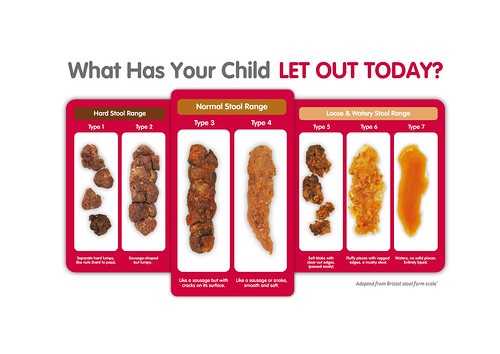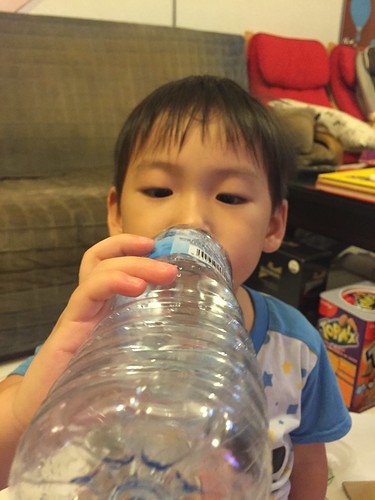Did you know tomorrow is World Digestive Health Day which falls on May 29, 2016. I am going to show you some not so palatable pics known as the Bristol Stool Chart so ensure you put down whatever you are eating before reading on. As messy a business as it seems, it is something important to talk about, the bowel movements in children and one of the most common issue amongst children that worry us parents sick – constipation[i].
My youngest, Jordan is now 4 and I had certainly spent a fare amount of hours sitting with him as he strains on the potty. The longest he went without a bowel movement was 3 days and it was definitely a very worrying issue for us, it made me wonder where did all that food that he ate went in his tiny body and how terrible he must be feeling with all that pain. When that poop does come out, it is not something we want to inspect close up, we want to flush it off immediately, but it is actually important to check it out as it is one of the indicators of your child’s gut health. Having a healthy gut helps your child to digest and absorb important nutrients from food which is essential for the healthy development of your growing child. Here are some tips which can help promote a healthy gut for your child.
What’s Normal, What’s Not?
Poop more formally known as feces or stool, is a waste matter that is discharged from the bowels after food has been digested. How the poop looks may vary everyday if you ever take notice, and it usually depends on what your child has eaten that day. It is actually a good habit to keep track of fecal features, such as shape, size, color, frequency and also consistency, as that will help us to understand our child’s gut health better and ensure their overall health and well-being.
The Bristol Stool Chart[ii] is a useful guide commonly used by paediatricians that can assist you to distinguish types of stool.
- Type 1 and 2 suggest a potential risk of constipation
- Type 3 and Type 4 are normal stools which indicate a healthy gut
- Type 5, 6 and 7 suggest potential risks of infection or diarrhea, to which parents are advised to seek medical advice for the welfare of their children
When my child have constipation. it generally involve infrequent, difficult, painful or incomplete release of hardened stools in children. Even when the stool comes out, it usually is dark and in small pieces. I cannot imagine this but when the food residue remains in the large intestine for an extended period of time, too much water can be absorbed, and as a result, stools become harder and drier. When your child is trying to pass a large or hard stool, it will stretch the rectal walls and may lead to tearing and bleeding[iii], thus they feel the pain. When the child feels the pain, it will cause the child to even more hold in the stool and avoid passing motion as the fear and pain causes anxiety and they want to avoid the unpleasant experience, thereby creating a vicious cycle. That is why I get really anxious if Jordan missed his daily poo time as I know it will harden the next day and makes it that much harder for it to come out.
Constipation: Prevention is the Key
There are many factors that can contribute to constipation in children, such as variations in diet, developmental stage, environmental issue, emotional status or illness. To prevent constipation in your child and maintain a good gut health, here are a few recommendations:
- Consistently offer foods rich in dietary fibre, such as whole grain foods, fruits and vegetables in you and your child’s diet. Children from 3-6 years old are recommended to consume 2 servings of fruits and 2 servings of vegetables daily[iv]. Parents have great influence on children’s eating habits, so if your children see you eating plenty of fruits and vegetables, they are more likely to follow your lead and be more receptive to all the food you consume. Hence, it is important for you to be a role model to your children.
- Fluids. It is essential to keep children well hydrated, as inadequate intake of fluids will lead to constipation. Children between 2-3 years old are recommended to drink 1-2 glasses of plain water per day while children 4 years old and above are recommended to drink 6-8 glasses per day[iv]
- Toilet Training. Studies show that there are two transitional periods in which a child is particularly prone to constipation; the first being at the time of toilet training, and during the start of school[v]. Parents are advised to encourage to your child to use the toilet regularly, such as first thing in the morning or 10 to 30 minutes after a full meal[vi]. Regular bowel movement whereby your child’s stool consistency is soft is one of the signs of a healthy gut.
- Research has shown that prebiotics such as fructo-oligosaccharides (FOS) and galacto-oligosaccharides (GOS) can help to promote softer stools for easier bowel movement[vii]. Prebiotics oligosaccharide mixture GOS/IcFOS (9:1) helps increase intestinal bifidobacteria and hence helps to maintain a good intestinal environment[viii]. With good intestinal environment and good gut health, your child will experience fewer digestive discomforts, including constipation.

The digestive system, or gut, is a complex system that begins with the breaking down of food and ends with the elimination of waste products as stools. Proper functioning of the digestive system is important as it allows absorption of essential nutrients which children need for healthy growth and development[viii]. In essence, good digestion is key to good health, it is an important part of your child’s overall health and sense of well-being. To set the foundation for a healthy life, let’s ensure your child consumes enough fibre, water and foods containing prebiotics – it’s never too late to make good gut health a priority!
[i] Van den Berg MM, Benninga MA, Di Lorenzo C.. Am J Gastroenterol 2006: 101(10):2401-9
[ii] SJ Lewis et al. Scand. J. Gastroenterol. 1997; 32(9):920-4
[iii] A Rowan-Legg. Canadian Paediatric Society Community Paediatrics Committee, Peadiatr Child Health 2011;16(10):661-5
[iv] Malaysian Dietary Guidelines for Children and Adolescents 2013
[v] North American Society for Pediatric Gastroenterology, Hepatology and Nutrition. J Pediatr Gastroenterol Nutr 2006; 43:405-7
[vi] National Digestive Diseases Information Clearinghouse (NDDIC)
[vii] Moro G et al. J Pediatr Gastroenterol Nutr. 2002; 34(3):291-5.
[viii] Guide to Nutrition Labelling and Claims, Food Safety and Quality Division, Ministry of Health Malaysia. (2010)




Can the chart be used to reflect on adult’s poop too? Sigh. Guess i should start practicing the constipation prevention! 😀
it definitely applies to adults too!
Gonna share the article with my sisters so that they will know what to do. Thanks for the info.
thanks for the information, i have to share this article with my friends and family really good information
I’m glad to not have constipation problem><" Read some articles related to these too! Gonna let more people know about these :)
LOL I learn about poops before… because I kinda have serious constipation before! Oops 😀 Its good to know what your body is trying to tell you
Huhu… I have gone through all stages of that poop thingie.. and well now that my kids are grown up, I hope not to see anyone’s poop anymore other then my own- that also because I have to… LOL
it’s very important to know this. my teacher always tells me your body will tell you things. the signs are important and cannot neglect. 🙂
Poop really tells you the condition of your digestive system ~ Sometimes i also observe myself ~haha
definitely a great post.. sometimes we just takes things for granted and lightly.. so these info is definitely gonna help mom n dads out there!
Thanks for sharing! Know something about ‘poop’ XD
great to have a short crash course reminder here 😛
There was once my cousin took a photo of his kid’s poop and send it to our group chat… Cos we all needed to see poop early in the morning. hahahahah…
I guess now I understand why he took the poop photo… for research!
This is a really good info to know about poop and whats your children digestive condition! Eat more fruits and vege XD
A good sharing as parent should watch their children poop and encourage their children drink more water .
I always let my children to eat fruits and yogurt drinks to ensure they had poo everyday.
Its a good information and tips to all the parents and adults also. Sometimes we faced indigestion too.
It is necessary that we monitor the poo poo of kids and ourselves also. Body gives us so many signals.
Hehe, didn’t know about this until I read your post, thanks for the info sharing 🙂
Not only child la.. We also can understand from our own whether we drink enough water or any problem… hehe.. Thanks for sharing..
great post for daddy and mummy The poop poop really can tell everything
The poop poop really can tell everything
Poop on! :D.. always good to get more knowledge.